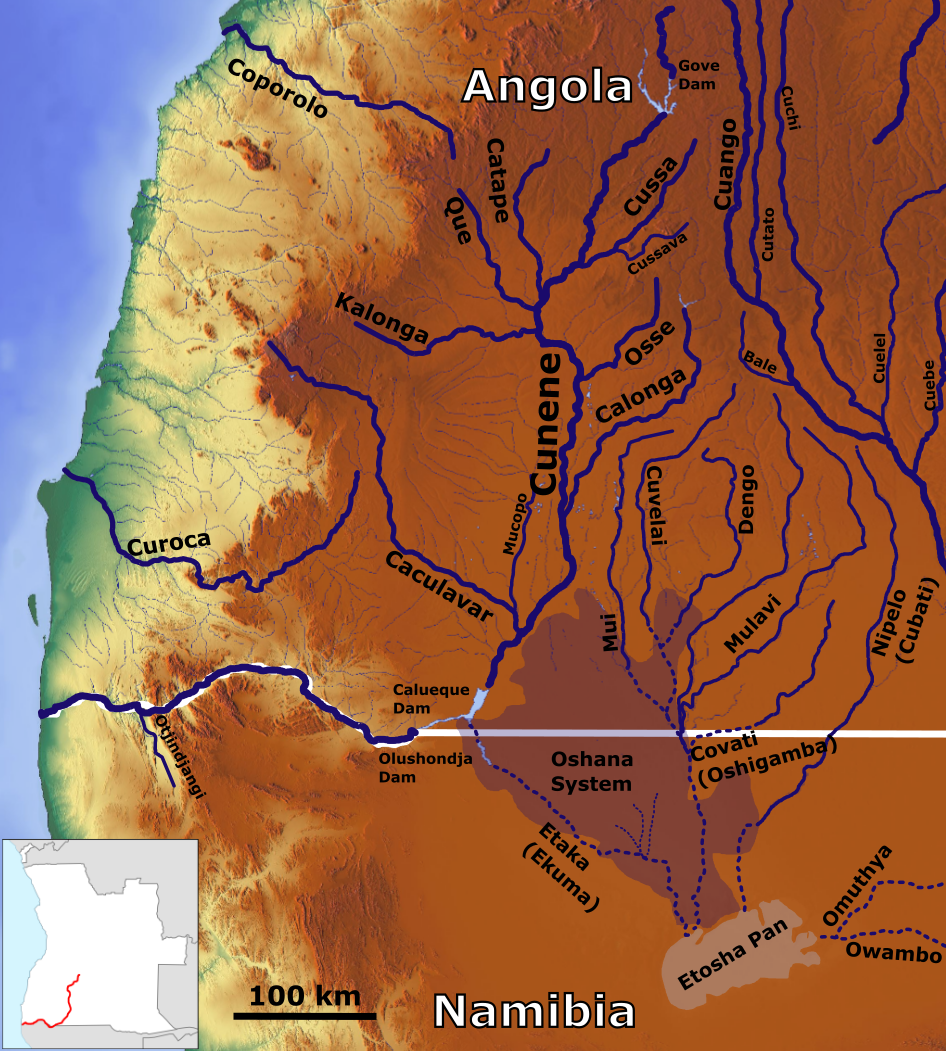Omaramba River on:
[Wikipedia]
[Google]
[Amazon]
 The Omuramba Ovambo is an
The Omuramba Ovambo is an
 The Omuramba Ovambo is an
The Omuramba Ovambo is an omuramba
Omuramba (plural: ''Omiramba'') is the term for ancient river-beds found in the Kalahari Desert of Africa, notably in the North Eastern part of Namibia and North Western part of Botswana. The word is taken from the Herero language. An omuramba pro ...
(dry river bed) in Namibia
Namibia (, ), officially the Republic of Namibia, is a country in Southern Africa. Its western border is the Atlantic Ocean. It shares land borders with Zambia and Angola to the north, Botswana to the east and South Africa to the south and ea ...
. It originates about five kilometers from Tsintsabis and flows into Etosha Pan
The Etosha Pan is a large endorheic salt pan, forming part of the Cuvelai-Etosha Basin in the north of Namibia. It is a hollow in the ground in which water may collect or in which a deposit of salt remains after water has evaporated. The 120-kilo ...
. Its catchment area
In human geography, a catchment area is the area from which a location, such as a city, service or institution, attracts a population that uses its services and economic opportunities. Catchment areas may be defined based on from where people are ...
is . This river only flows when there is heavy rainfall. The river has almost no organic life in it due to its fluctuating water levels. The river banks are filled with rows of Camelthorn and Acacia tree
''Acacia'', commonly known as the wattles or acacias, is a large genus of shrubs and trees in the subfamily Mimosoideae of the pea family Fabaceae. Initially, it comprised a group of plant species native to Africa and Australasia. The genus ...
s which provide shade to the surrounding animals and San people
The San peoples (also Saan), or Bushmen, are members of various Khoe, Tuu, or Kxʼa-speaking indigenous hunter-gatherer cultures that are the first cultures of Southern Africa, and whose territories span Botswana, Namibia, Angola, Zambia, ...
who live in the area.
San people
The main towns in which the San live in Namibia are Tsintsabis andTsumkwe
Tsumkwe ( Juǀ'Hoan: Tjumǃkui) is a settlement in the Otjozondjupa Region of Namibia and the district capital of the Tsumkwe electoral constituency.
Nature and wildlife
The area associated with Tsumkwe exhibits notable vegetation and wildlife. ...
near the sand valley " Boesmanland". Near the river is a large village with a community of San which mostly depend on the river's resources. These people have very little money, and unfortunately are very secluded from the rest of society so they must buy most things at a very high price due to travel costs. Fortunately once or twice every year during heavy rainfall the bushmen have the chance to gather water (as Tsintsabis is a very dry and hot place) and also catch fish, although preservation can sometimes be an issue. The most abundant fish is the Barbel Barbel may refer to:
*Barbel (anatomy), a whisker-like organ near the mouth found in some fish (notably catfish, loaches and cyprinids) and turtles
*Barbel (fish), a common name for certain species of fish
**''Barbus barbus'', a species of cyprinid ...
due to its ability to burrow under muddy ground to keep itself safe from the harsh air and sun when the river is not flowing.
Tourism
The Omuramba Ovambo has become a tourist attraction, where many people go for a relaxing day trip. One can barbecue on the banks of the Omaramba, and due to the lack of crocodiles, it is a safe place to swim.Omaramba river information in the Namibian GetawaySee also
*List of rivers of Namibia
This is a list of streams and rivers in Namibia, arranged geographically by drainage basin.
Flowing into the Atlantic Ocean
* Hoanib River
** Aap River
** Ganamub River
** Mudorib River
** Ombonde River
*** Honib River
*** Otjovasandu ...
References
Rivers of Namibia {{Namibia-river-stub